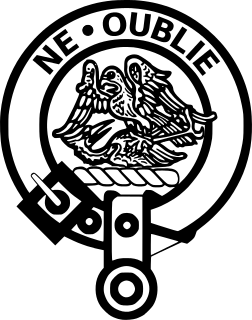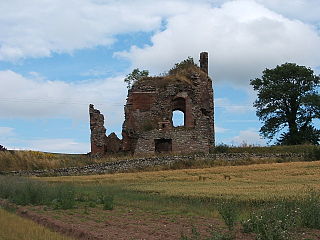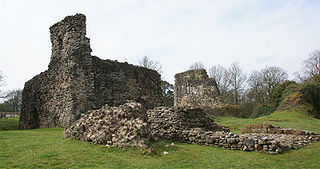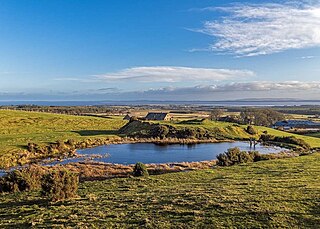| Auldearn Castle | |
|---|---|
| Auldearn, Highland, Scotland | |
| Coordinates | 57°34′39″N3°48′44″W / 57.5776110°N 3.8123252°W |
| Site history | |
| Built | 12th century |
Auldearn Castle [lower-alpha 1] was a castle near the village of Auldearn, Highland in Scotland.
| Auldearn Castle | |
|---|---|
| Auldearn, Highland, Scotland | |
| Coordinates | 57°34′39″N3°48′44″W / 57.5776110°N 3.8123252°W |
| Site history | |
| Built | 12th century |
Auldearn Castle [lower-alpha 1] was a castle near the village of Auldearn, Highland in Scotland.
Constructed as an earth and timber motte-and-bailey castle during the reign of William the Lion in the late 12th century. [1] The castle was handed over by the constable Gillecolm de Madderty to Donald Meic Uilleim during a revolt in Moray in 1187. It was a royal castle used by the Scottish Crown. The castle was the site of the fealty of William, Earl of Ross to King Robert the Bruce in 1308.

A motte-and-bailey castle is a European fortification with a wooden or stone keep situated on a raised area of ground called a motte, accompanied by a walled courtyard, or bailey, surrounded by a protective ditch and palisade. Relatively easy to build with unskilled labour, but still militarily formidable, these castles were built across northern Europe from the 10th century onwards, spreading from Normandy and Anjou in France, into the Holy Roman Empire in the 11th century. The Normans introduced the design into England and Wales following their invasion in 1066. Motte-and-bailey castles were adopted in Scotland, Ireland, the Low Countries and Denmark in the 12th and 13th centuries. Windsor Castle, in England, is an example of a motte-and-bailey castle. By the end of the 13th century, the design was largely superseded by alternative forms of fortification, but the earthworks remain a prominent feature in many countries.

The Battle of Kilsyth, fought on 15 August 1645 near Kilsyth, was an engagement of the Wars of the Three Kingdoms. The largest battle of the conflict in Scotland, it resulted in victory for the Royalist general Montrose over the forces of the Covenanter-dominated Scottish Parliament, and marked the end of General William Baillie's pursuit of the Royalists.

Clan Graham is a Scottish clan who had territories in both the Scottish Highlands and Lowlands.

Tibbers Castle is a motte-and-bailey castle overlooking a ford across the River Nith in Dumfries and Galloway, Scotland. To the east is the village of Carronbridge and to the north west is a 16th-century country house, Drumlanrig Castle.

Auldearn is a village situated east of the River Nairn, just outside Nairn in the Highland council area of Scotland. It takes its name from William the Lyon's castle of Eren, built there in the 12th century.
Clan Straiton, also called Straton or Stratton, is a Lowland Scottish clan. The clan does not currently have a chief therefore it is considered an Armigerous clan.
The Motte of Urr is the remains of a 12th-century motte-and-bailey castle located near the Haugh of Urr in Dumfries and Galloway, Scotland.

Torthorwald Castle is a large ruined rectangular tower at the centre of the village of Torthorwald just outside Dumfries in south west Scotland. The first castle on the site was an earthwork motte-and-bailey built in the 12th century. The earliest building which forms part of the current ruins was built in the 14th century.

Lochmaben Castle is a ruined castle in the town of Lochmaben, the feudal Lordship of Annandale, and the united county of Dumfries and Galloway. It was built by Edward I in the 13th and 14th centuries, and later rebuilt during the reign of James IV of Scotland. An earlier motte-and-bailey castle was built south of the current castle in c. 1160 by the Bruce family, Lords of Annandale.

Liddel Castle is a ruined castle in Liddesdale, by the Liddel Water, near Castleton in the Scottish Borders area of Scotland, in the former county of Roxburghshire. Liddel Castle is a scheduled monument.

Cullen Castle was a royal castle about 0.5 miles (0.80 km) west of Cullen, Moray, Scotland, west of the burn of Deskford, and south of Seatown. The remains have been designated as a Scheduled Ancient Monument, accessible to the public. This is not to be confused with Cullen House or Castle of Cullen of Buchan. There is also a ruin of a Cullen Castle in County Waterford, Ireland.
Cromarty Castle was a castle in Cromarty, Scotland. Cromarty, then known as Crumbathyn, was created a royal burgh in the reign of King Alexander I of Scotland. Cromarty overlooks the entrance to the Cromarty Firth and was strategically important. A motte-and-bailey castle was built in the 12th–13th century. The castle was held by Sir William de Monte Alto during the Scottish wars of independence for both the English and the Scottish.

Kirkintilloch Castle was located in Kirkintilloch, East Dunbartonshire, Scotland.

Lochwood Tower, also known as Lochwood Castle, is a ruined 16th-century L-plan tower house, about 6 miles (9.7 km) south of Moffat, Dumfries and Galloway, Scotland.

Lochore Castle is a ruined 14th-century tower house, about 3 miles (4.8 km) south east of Cowdenbeath, Fife, Scotland, and south of Lochore, east of Loch Ore, in Lochore Country Park.
Biggar Castle was a 12th century castle in Biggar, South Lanarkshire, Scotland. It appears to have been abandoned by the 14th century.

Boghall Castle was a 14th century castle to the south of Biggar, South Lanarkshire, Scotland. Boghall became ruinous in the 19th century.

Proncy Castle is a ruined castle located near Dornoch, Highland, Scotland. It is within the historic county of Sutherland. The castle is positioned to command open views to the south over the Dornoch Firth.
Kinsteary House is a manor house and site of a possible castle located south of Auldearn, Highland in Scotland.